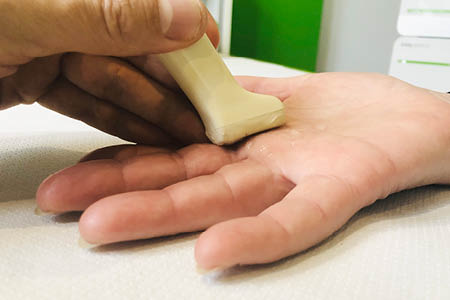Prof. Dr. Karsten Knobloch, FACS
Tendon entrapment of the long fingers and the thumb is one of the most frequent causes of hand pain and disability. The condition causes painful catching or popping of the involved flexor tendon as the patient flexes and extends the digit affected. On occasion, the affected digit will lock in flexion requiring passive manipulation of the finger to obtain full extension again.
In 1850 Notta3 described trigger finger as a condition caused by changes to the flexor tendon and its sheath with a painful nodule, later called Notta’a nod- ule on his behalf. Hueston and Wilson4 demonstrated in an anatomical study that the spiral arrangement of the architecture of the intratendon fibers lead to the formation of nodules that form distally to the A1 pulley.
A recent survey from Taiwan5, published in January 2019 among 41,871 cases listed in the Taiwan National Health Insurance Research Database reported the following:
-
| The authors found that 1.59% of the population developed carpal tunnel syndrome, 0.49% developed de Quervain's tendinopathy, and 1.07% devel- oped trigger finger.
-
| Cases were more likely to develop these 3 hand tendinopathies, if they were female, between 50 and 59 years old, and, according to a multivariate analysis, comorbid with RA, diabetes, using hormone antagonists.
A retrospective analysis6 on 1,386 hands in 1140 patients who underwent carpal tunnel release found the following:
-
| Of 1,386 hands, a new trigger finger was seen in 147 (10.6%) within 1 year before carpal tunnel release and 81 (5.8%) within 1 year after carpal tunnel release.
-
| There is a predisposition for these 2 common hand pathologies to present in the same hand; however, patients can be counseled that carpal tunnel release does not cause new incidence of trigger finger in the operative hand.
Facts on trigger finger epidemiology:
-
| The incidence of trigger finger is 28: 100,000 per year.
-
| The lifetime risk of trigger finger is 2.6% in the general population,7 but it
increases to 10% in the diabetic population.
-
| The mean age of onset for trigger finger is 58 years and it is diagnosed in
women two to six times more frequently than men.8
Typically, there is a continuum from the healthy flexor tendon to a catching or popping tendon to the fixed and locked tendon
ANATOMY
Fingers have a retinacular pulley system10 around the flexor tendons. These pulleys are the focal thickened area of the flexor tendon sheaths. It allows the flexor tendon to glide inside it smoothly.
Tendon entrapment is due to mechanical impingement of the inflamed flexor tendon as its passes through the retinacular pulley or anular ligament at the level of the metacarpal head, which is called A1 pulley.11 Proximal phalangeal flexion in power grip caused high angular loads at the distal edge of the first annular (A1) pulley. The most remarkable pathologic changes are seen in the pulley itself, which demonstrates gross hypertrophy, described by Bunnel as a whitish, cicatricial collar-like thickening.
DIAGNOSTICS
Besides clinical palpation when moving the affected finger passively with pain and intermittent locking in the A1 region, diagnostic ultrasound plays a major role in trigger finger diagnostics.
Beyond the diameters of the superficial and the deep flexor tendons at various locations, pulley ganglioma can be visualized with high resolution ultrasound.
-
Weitere Informationen zu diesem Artikel finden Sie in unserem Fachbuch ESWT in Hand Surgery von Prof. Karsten Knobloch.
Mit einem Klick zu unseren informativen Fachbüchern im Bereich Stoßwellen-Therapie.
Informieren Sie sich jetzt!

Jetzt informieren: Level-books.com
